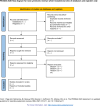Prevalence and risk factors of early postoperative seizures in patients with glioma: A protocol for meta-analysis and systematic review
- PMID: 38574171
- PMCID: PMC10994364
- DOI: 10.1371/journal.pone.0301443
Prevalence and risk factors of early postoperative seizures in patients with glioma: A protocol for meta-analysis and systematic review
Abstract
Introduction: Early postoperative seizures has been the most common clinical expression in gliomas; however, the incidence and risk factors for early postoperative seizures in gliomas are more controversial. This protocol describes a systematic review and meta-analysis to clarify the prevalence and risk factors of early postoperative seizures in patients with glioma.
Methods and analysis: Searches will be conducted on CNKI, WanFang, VIP, PubMed, Embase, Cochrane Library databases and Web of Science for the period from database inception to December 31st, 2023. Case-control and cohort studies of the incidence and risk factors for early postoperative seizures in all gliomas will be included. The primary outcome will be incidence, risk factors. Newcastle-Ottawa Scale was used for quality evaluation. Review of article screening, extracting data and risk of bias assessment will be repeated by two independent reviewers.
Result: This study will provide evidence for the risk factors and incidence of early postoperative seizures in patients with glioma.
Conclusion: Our study will provide evidence for the prevention of early postoperative seizures in glioma patients.
Trail registration: This protocol was registered in PROSPERO and registration number is CRD42023415658.
Copyright: © 2024 Sun et al. This is an open access article distributed under the terms of the Creative Commons Attribution License, which permits unrestricted use, distribution, and reproduction in any medium, provided the original author and source are credited.
Conflict of interest statement
I have read the journal’s policy and the authors of this manuscript have the following competing interests: [The authors have declared that no competing interests exist.]
Figures

Similar articles
-
Incidence, risk factors, and outcomes of early postoperative hyperglycemia in surgical patients: a protocol for a systematic review and meta-analysis.Syst Rev. 2020 Jul 13;9(1):158. doi: 10.1186/s13643-020-01416-4. Syst Rev. 2020. PMID: 32660607 Free PMC article.
-
Correlation between glioma location and preoperative seizures: a systematic review and meta-analysis.Neurosurg Rev. 2019 Sep;42(3):603-618. doi: 10.1007/s10143-018-1014-5. Epub 2018 Aug 3. Neurosurg Rev. 2019. PMID: 30073426
-
Prevalence and risk factors of early postoperative seizures in patients with glioma: a systematic review and meta-analysis.Front Neurol. 2024 Mar 20;15:1356715. doi: 10.3389/fneur.2024.1356715. eCollection 2024. Front Neurol. 2024. PMID: 38572493 Free PMC article.
-
Incidence of constipation and associated factors in the period of lockdown during COVID-19 pandemic: protocol for a systematic review and meta-analysis.BMJ Open. 2023 Sep 29;13(9):e069614. doi: 10.1136/bmjopen-2022-069614. BMJ Open. 2023. PMID: 37775294 Free PMC article.
-
Efficacy of TTFields in high-grade gliomas: a protocol for systematic review and meta-analysis.BMJ Open. 2023 Sep 20;13(9):e073753. doi: 10.1136/bmjopen-2023-073753. BMJ Open. 2023. PMID: 37730390 Free PMC article.
Cited by
-
A privacy-preserved horizontal federated learning for malignant glioma tumour detection using distributed data-silos.PLoS One. 2025 Feb 11;20(2):e0316543. doi: 10.1371/journal.pone.0316543. eCollection 2025. PLoS One. 2025. PMID: 39932966 Free PMC article.
References
MeSH terms
LinkOut - more resources
Full Text Sources
Medical

